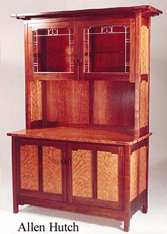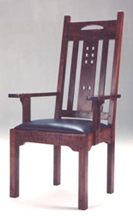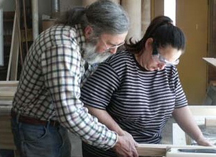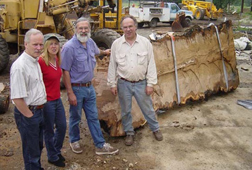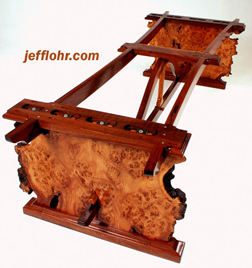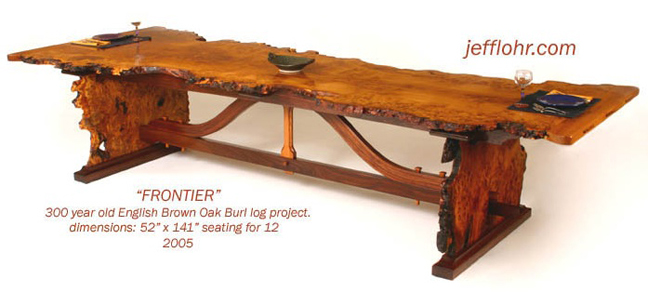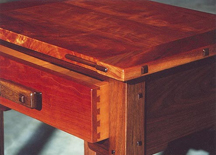
Jeff Lohr spent the first half century of his life crafting a career as a fine furniture maker, designer and teacher, garnering awards along the way for both his Arts and Crafts style furniture designs and his teaching skills. Then, when he was in his early 50s, a life-threatening experience sent him off on a completely different tangent, resulting in a new direction in woodworking. It’s quite a story, and it all started back in high school.
“I was the proverbial ‘shop king’ in high school,” Jeff recounted. “I took every shop class I could fit into my schedule and spent every minute I could in the shop. Both my father and brother were tool and die makers, so everyone assumed I would be a metal worker. However, a high school shop teacher who also owned his own woodworking company in Intercourse, Pennsylvania, got me interested in woodworking.
“After high school, I went to work for two years in a variety of jobs, then went to Millersville State College for Industrial Arts with a wood major. It took me six years to get through because I’d frequently drop out to work to get money for my next round of education. I graduated with honors in 1976 and was inducted into Epsilon Pi Tau, an honorary fraternity for woodworkers and other shop types.
“My first job was teaching woodshop in middle school for two years, then I moved to teaching in high school. My program was somewhat unique in that we built things like a cold molded sailboat, high-end furniture and steam bent toboggans; in short, something other than just lamps and letter holders. I did that for 13 years until 1989, picking up a teacher of the year award along the way.
“My first job was teaching woodshop in middle school for two years, then I moved to teaching in high school. My program was somewhat unique in that we built things like a cold molded sailboat, high-end furniture and steam bent toboggans; in short, something other than just lamps and letter holders. I did that for 13 years until 1989, picking up a teacher of the year award along the way.
“While I liked teaching, I felt hamstrung in not being able to pursue some of the more challenging projects I was interested in, including my own designs. By 1988, I was complaining that I really wanted to do something other than having to start over again with each new class. My wife pushed me to quit and do what I really wanted to do. Had it not been for her, I doubt I would have taken the risk. I bought a pickup truck, saved up 8,000 dollars, and opened JD Lohr Woodworking the next year.
“It was tough going. I made only about 4,000 dollars the first year, and not much more the next, but little by little, things improved. The first 15 years of my woodworking career, I never made a comfortable living, but I was fortunate enough to have a working wife who was very supportive of what I wanted to do, both economically and emotionally. Within six years, I worked up to four employees, but it meant I had to spend too much time hustling work and not enough time in the shop. It was the same problem I had faced while teaching: not enough bench time.
“Initially, I would do anything that came in, from interior built-ins to porches and high-end carpentry. That morphed into doing furniture for interior decorators and the design trade, which let me do more traditional designs, running the gamut from reproduction Queen Anne and Chippendale to faux painted furniture. I was getting everything you could imagine, from vanities and dining tables to swing sets for customers’ kids.
“One day, I found a book in a used book store called Inside the Craftsman Home and was taken with the simplicity and honesty of Mission design. Some time later, I read an issue of a magazine that showcased Greene and Greene, and was taken with them, and with Frank Lloyd Wright. At first, I had a hard time convincing clients that Arts and Crafts was both a legitimate and very beautiful style, but a chance meeting would change that.
“One day, while at a furniture show I met Ralph Kovel, one of a pair of brothers famed as antique and collectible experts. He liked my designs and hired me to design and build 28 pieces of furniture for the Kovel brothers’ homes and office. I was paid to do the design work, yet ended up with many designs that I continued to sell to others. That was a starting point, and I continued to design other pieces, focusing strongly on Arts and Crafts and taking my directions from the classics, like Greene and Greene, Mackintosh and Wright.
“It was while I was working on a new 3,600 square foot shop in 2000 that I realized I missed teaching and decided to add it back into my life. I told a few friends, and a class started. That grew into a program that now accepts 72 students per year in eight classes of nine students, each of whom spends a full week working on the physics of woodworking via a project. Called Practical Woodworking, it is almost a theatrical event, starting from how the tree grows and progressing through to how you can safely work the material into whatever form you want it to be. While they make a table, I consider the table itself a byproduct of the class. It is really about how to cherish and control the material.
“In 2001, I got a commission from former customers Jeremy and Debbie Allen to do a freeform table from one single tree. It took about a year, but I finally found the right log: a huge English brown oak whose entire trunk was burl. It was more than three hundred years old and came from the estate of the duke of Northumberland. Buying it was a big risk, since you don’t know what you will find when you cut open a log, but we lucked out.
“What makes brown oak out of English oak is the attack of beefsteak mushroom growth that causes the wood to turn brown and spread burl throughout the tree. Once the disease hit, it took 200 years for the tree to die.
“In January of 2005, as the cut slabs were drying, I had a heart attack and nearly died. I spent 13 days in intensive care, went through quadruple bypass surgery, and went into a deep depression. I did not know whether to go ahead or not, but the customer had bought the wood, so I contacted him.
“Unbeknownst to me, the whole reason for the project was eerily similar to what I was experiencing. Mr. Allen had been diagnosed with prostate cancer in 2001. He and his wife had seen a freeform table years ago and decided the long-term process going from picking the tree to the finished piece was just what they needed to give him a focus for living, and to help overcome depression. As he confessed all this to me, I became convinced to go on with the project. Hence three elements – a sick customer, a recovering woodworker and a dying tree – came together to create a living memorial to all three of us, and one that should last for many decades to come.
“The piece is called Frontier because it opened new frontiers for me. It is far and away my favorite piece and inspired a new direction toward freeform designs. I bought a band mill and am now building pieces where the tree defines the direction of the final piece rather than me forcing it into squares. In a way, it is an about-face from Arts and Crafts.”
As for Mr. Allen, he and Jeff became lifelong friends, and both of are doing great. For that matter, the table is also doing great, though it is almost certain to outlast its creators by at least four score and seven.
